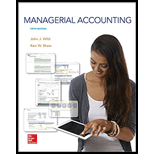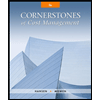
(1)
Concept introduction:
Money (cash)
To prepare:
Table showing cash collected through credit sales (balance due) in June and July.
Answer to Problem 7PSA
| Particulars | April $ | May $ | June $ | July $ | August $ |
| Collection made | 144000 | 432000 | 597600 | 820800 | 889200 |
Explanation of Solution
Table of collection through Money(cash)
| Particulars | April $ | May $ | June $ | July $ | August $ |
| Sales | 720000 | 360000 | 1080000 | 900000 | 684000 |
| Collection made |
(2)
Concept introduction:
Money (cash) forecast: Money (cash) acceptance forecast amounts to the outflow and inflow of money (cash) in the forecast period to ascertain the equilibrium of money (cash) commitment.
To prepare:
Budget inventory (ending) for April, May, June and July.
Answer to Problem 7PSA
| Particulars | April $ | May $ | June $ | July $ |
| Closing inventory | 400 | 1200 | 1000 | 760 |
Explanation of Solution
Computation of forecasted (budgeted) closing stock for April, May, June, and July.
| Particulars | April $ | May $ | June $ | July $ | August $ |
| Unit | 4000 | 2000 | 6000 | 5000 | 3800 |
| Closing inventory(20*of succeeding month sales) | 400 | 1200 | 1000 | 760 | - |
(3)
Concept introduction:
Money (cash) forecast: Money (cash) acceptance forecast amounts to the outflow and inflow of money (cash) in the forecast period to ascertain the equilibrium of money (cash) commitment.
To prepare:
Purchase budget for May, June and July.
Answer to Problem 7PSA
| Particulars | April $ | May $ | June $ | July $ |
| Units to be bought | 4500 | 2900 | 5900 | 4860 |
Explanation of Solution
Purchase forecast (budget):
| Particulars | April $ | May $ | June $ | July $ | August $ |
| Units | 4000 | 2000 | 6000 | 5000 | 3800 |
| Less-beginning inventory | - | 400 | 1200 | 1000 | 760 |
| Add-ending inventory | 400 | 1200 | 1000 | 760 | - |
| Add-stock for safety | 100 | 100 | 100 | 100 | 100 |
| Units to be bought | 4500 | 2900 | 5900 | 4860 | 3140 |
(4)
Concept introduction:
Money (cash) forecast: Money (cash) acceptance forecast amounts to the outflow and inflow of money (cash) in the forecast period to ascertain the equilibrium of money (cash) commitment.
To prepare:
Table showing cash payment in June and July.
Answer to Problem 7PSA
| Months | June$ | July$ |
| Amount | 484000 | 594000 |
Explanation of Solution
Cash schedule for payment
| Particulars | April$ | May$ | June$ | July$ | August$ |
| Unit | 4000 | 2000 | 6000 | 5000 | 3800 |
| Price /unit | 110 | 110 | 110 | 110 | 110 |
| Purchase | 440000 | 220000 | 660000 | 550000 | 418000 |
| Amount |
(5)
Concept introduction:
Money (cash) forecast: Money (cash) acceptance forecast amounts to the outflow and inflow of money (cash) in the forecast period to ascertain the equilibrium of money (cash). commitment.
To prepare:
Answer to Problem 7PSA
Total of cash in June and July is same i.e. 100000
Explanation of Solution
Cash budget
| Particulars | June | July |
| Cash received | 597600 | 820800 |
| Less-cash paid | 660000 | 550000 |
| Less-expenses for sales | 1320000 | |
| Amount for loan | 1382400 | 1377488 |
| Less-interest paid amount | - | 1658888 |
| Cash | 100000 | 100000 |
(6)
Concept introduction:
Money (cash) forecast: Money (cash) acceptance forecast amounts to the outflow and inflow of money (cash) in the forecast period to ascertain the equilibrium of money (cash) commitment.
To discuss:
Reasons that would help the firm manage cash for the month of May.
Answer to Problem 7PSA
If it was known to the company that it required more borrowing in June, i.e., more than $18000 as per the cash budget of the company in May itself, then company would have made less investment in May so that borrowing would have not been required that much in June. Also, the company would have realised its amount receivable from the customer to whom credit sales has been made.
Explanation of Solution
If it was known to the company that it required more borrowing in June, i.e., more than $18000 as per the cash budget of the company in May itself, then the company would have made less investment in May so that the borrowing would have not been required that much in June. Also, the company would have realised its amount receivable from the customer to whom credit sales has been made.
Want to see more full solutions like this?
Chapter 7 Solutions
MANAGERIAL ACCOUNTING FUND. W/CONNECT
- I am looking for the correct answer to this general accounting problem using valid accounting standards.arrow_forwardPlease help me solve this general accounting problem with the correct financial process.arrow_forwardPlease provide the answer to this general accounting question using the right approach.arrow_forward
- I need help with this general accounting question using standard accounting techniques.arrow_forwardmanagerial accounting questionarrow_forwardA firm is considering making a change to its capital structure to reduce its cost of capital and increase firm value. Right now, it has a capital structure that consists of 20% debt and 80% equity, based on market value. The risk-free rate is 6% and the market risk premium is 5%. Currently the company's costs of equity, which is based on the CAP<, is 12.5% and its tax rate is 40%. What would be Carwright's estimated cost of equity if it were to change its capital structure to 60% debt and 40% equity?arrow_forward
- A company has the following data, in thousands. Assuming a 365-day year, what is the firm's cash conversion cycle? Annual Sales = $45,000 Annual cost of goods sold = $31,500 Inventories = $4,250 Accounts receivable = $2,000 Accounts payable = $3,400arrow_forwardaccounting questionarrow_forwardsubject = general accountingarrow_forward
- Principles of Accounting Volume 2AccountingISBN:9781947172609Author:OpenStaxPublisher:OpenStax College
 Managerial Accounting: The Cornerstone of Busines...AccountingISBN:9781337115773Author:Maryanne M. Mowen, Don R. Hansen, Dan L. HeitgerPublisher:Cengage Learning
Managerial Accounting: The Cornerstone of Busines...AccountingISBN:9781337115773Author:Maryanne M. Mowen, Don R. Hansen, Dan L. HeitgerPublisher:Cengage Learning Managerial AccountingAccountingISBN:9781337912020Author:Carl Warren, Ph.d. Cma William B. TaylerPublisher:South-Western College Pub
Managerial AccountingAccountingISBN:9781337912020Author:Carl Warren, Ph.d. Cma William B. TaylerPublisher:South-Western College Pub  Cornerstones of Cost Management (Cornerstones Ser...AccountingISBN:9781305970663Author:Don R. Hansen, Maryanne M. MowenPublisher:Cengage Learning
Cornerstones of Cost Management (Cornerstones Ser...AccountingISBN:9781305970663Author:Don R. Hansen, Maryanne M. MowenPublisher:Cengage Learning



